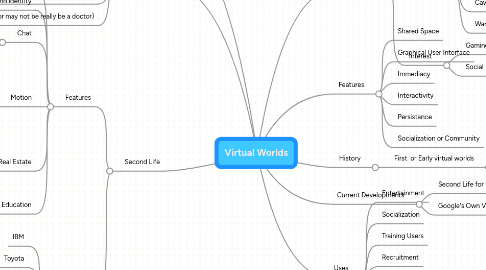Virtual Worlds
by Virtual World


1. Types
1.1. Social
1.2. Gaming
1.3. Hybrid
2. Second Life
2.1. Features
2.1.1. Resident
2.1.2. Appearance and identity
2.1.2.1. Avatars
2.1.3. Chat
2.1.3.1. Public Messaging
2.1.3.2. Private Messaging
2.1.4. Motion
2.1.4.1. Walk
2.1.4.2. Run
2.1.4.3. Fly
2.1.4.4. Teleport
2.1.5. Economy and Real Estate
2.1.5.1. Buy and sell products
2.1.5.2. Bid on lands
2.1.6. Education
2.1.6.1. Libraries
2.1.6.2. Lectures
2.2. Companies
2.2.1. IBM
2.2.2. Toyota
2.2.3. Dell
2.2.4. 20th Century Fox
2.2.5. Harvard
2.2.6. Reuters
3. Limitations
3.1. Fraud
3.2. a lot of time needed to develop
3.3. rules of virtual world are limited to developers
3.4. avatars are limited to the the platform it was created on
3.5. consulting on virtual world (the doctor may not be really be a doctor)
4. Features
4.1. Shared Space
4.2. Graphical User Interface
4.3. Immediacy
4.4. Interactivity
4.5. Persistance
4.6. Socialization or Community
5. History
5.1. First or Early virtual worlds
5.1.1. MUD
5.1.2. text based
5.1.3. limited graphical representation
6. Architecture
6.1. virtual world meets the real world
6.2. should be able to change or ability to change
6.3. Typologies
6.3.1. Offices with airconditioning systems
6.3.2. Scientific Laboratories
6.3.3. Space bases
6.3.4. Caverns
6.3.5. Warehouses
6.4. Interest
6.4.1. Gaming
6.4.2. Social
